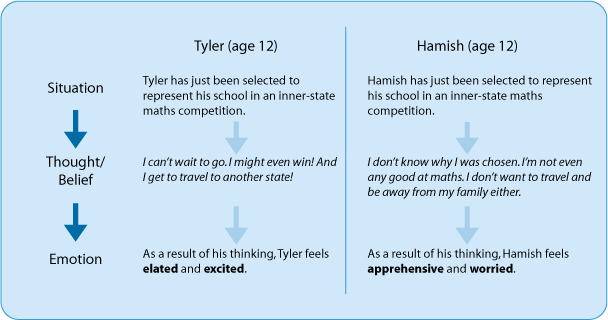Communication and Childhood Anxiety
Childhood worries and anxiety are a common challenge for many parents. In this post, we will be considering a cognitive-behavioural approach to working with children and their worries. A cognitive-behavioural approach works most effectively with children who are able to think in a structured sequence and understand cause and effect. This makes it more appropriate for children in older age brackets (approximately 7+ years).
Waters & Kennedy (1993) outline the relationship between our thoughts and emotions. The diagram below illustrates this relationship further.

Consider the example below:

Keeping a thought diary
For children who are prone to excessive worry or anxiety, it may be helpful for them to use a thought diary to record and track their thinking processes. This diary could consist of four columns, titled: day, situation, thoughts and feelings.
Children often find filling out the thoughts column to be the most difficult as thoughts are often fleeting and difficult to grasp. Children can be instructed that when keeping a diary they can leave the thoughts column blank and fill it in after discussion with their parent or counsellor.
Replacing negative thoughts with helpful thoughts
Once a child has identified the negative thoughts that led to a particular emotion, they can be guided to transform that negative thought into a helpful thought.
Avoiding false positives
A common mistake that parents make when attempting to generate helpful thoughts for a child is suggesting alternatives that are so positive they are unrealistic (to the child). False positives sound good in theory but, in reality, they are ineffective as children dismiss them as far-fetched.
Example:
A child, for example, who has just failed his fifth spelling test is unlikely to be reassured by the suggestion that he should change his thinking to?
“I am great at spelling. I will win the next spelling competition.” (false positive)
A more realistic option for this child would be?
“I can practise my spelling for an extra 10 minutes, every night, to improve my grades.” (helpful thought)


I am a great believer in CBT, the above article also provides evidence of its effectiveness for children. Children suffer from anxiety and worries no different to adults and the above strategies are an excellent form of coping strategies that can be utilised for children that are suffering from anxiety and worry in their life. Especially in todays society with divorce on the rise childhood stress, anxiety, and worry seems to be on the rise. So effective management of such stressors for children are an important factor in learning adequate coping skills that they can then take into their adult years.